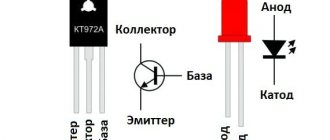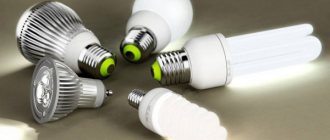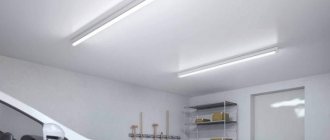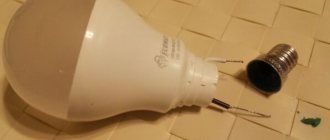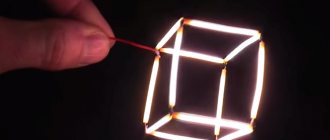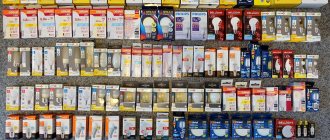Poor quality LED lamps
Take a closer look at the product costing from 125 rubles.
Anything cheaper is outright rubbish. Such lamps have a low-quality LED board that is not capable of dissipating enough heat. A bad case is also associated with “thermal” problems; they don’t even have the simplest driver. Power is provided through a ballast capacitor; no stabilization or protection is provided. In recent years, such specimens have gradually disappeared from the market. Install a varistor with an operating voltage of about 470 V in parallel with the lamp. This will reduce the risk - it will extinguish high-voltage surges.
You can improve such a light source by increasing the capacity of the filter capacitor on the board and installing a fuse if there is none.
How do LED lamps differ from each other?
Diode lamps, as a rule, differ from each other:
- Shape;
- Type of cooling;
- Number of LEDs;
- Power and color spectrum.
Cooling
The shape of the LED lamp plays a secondary role; other points are more important. I'll start with cooling, since there is a lot of envy from it.
Cooling can be: passive, active (cooler, fan).
Passive cooling of LED lamps provides natural cooling through the use of special materials with high thermal conductivity. Everything looks like this: in the back or bottom of the lamp there is a radiator, which naturally removes heat from the heating diode. Radiators can be flexible in the form of strips; often these simply do not fit into the headlight housing; as a result, you have to buy deeper protective covers.
The second type of cooling involves the presence of a so-called cooler, in other words, a fan that rotates and removes heat from the radiator. This type of cooling, despite its innovativeness and deceptive efficiency, is actually less reliable compared to lamps of the first type. Dust, moisture and other dirt, penetrating inside the cooler case, clog the fan, after which it fails. Without proper cooling, the LED lamp quickly overheats and can not only fail, but also melt. In more severe cases, everything can end in fire.
Number of LEDs. At first glance, it may seem that this parameter does not matter, but upon closer examination, the number of crystals plays an important role. One large diode is not always good; having several diodes is considered more acceptable. A large diode can heat up and therefore requires a large heatsink; therefore, the lamp may have large dimensions or poor cooling. In addition, a large diode often creates a beam of light that is too bright, which is not focused and blinds oncoming drivers. In addition, such LED lamps do not have a clear light boundary.
As for the power and color spectrum, everything is individual here; you need to select it according to your own preferences.
Heating temperature of LED lamps
An LED lamp, like all devices that convert electric current into light, generates some heat. Light sources based on LEDs heat up several times less when compared with incandescent lamps. In an LED lamp, neither the base nor the diffuser heats up. Heat is generated only on the LED crystal itself, and most of the heat is generated by the driver. Thermal energy is transferred to the radiator and is successfully dissipated by it.
It is important to understand how much LED lamps heat up for those who plan to use them near flammable objects - suspended ceilings, furniture, curtain lighting, etc. The heating intensity depends on the power and it is logical that a less powerful LED heats up less. The actual efficiency of lamps is estimated at 80%
The actual efficiency of the lamps is estimated at 80%.
Those. with an LED lamp power of 10 W, 2 W will be spent exclusively on heat generation. The heating temperature of an LED lamp reaches only 65 °C at its maximum hot point, compared to incandescent lamps, the temperature of which easily reaches 265 °C. So, when asked in stores “which light bulbs don’t heat up?” - meaning LED.
You also need to remember that the LED lamp has elements that heat up much more. Thus, the capacitor can heat up to more than 100 °C. And this is its absolutely normal operating temperature. The capacitor is placed on the driver and covered with a housing; it is impossible to remove it without damaging the structure.
As a result, we can identify several factors that determine how hot LED lamps become:
- The quality of materials of both the radiator and all components;
- Lamp power;
- Build quality;
- Ambient air temperature.
Lamp operating temperatures:
— Incandescent – depending on the power, the temperature can exceed 200 oC
- Halogen - they heat up even more than incandescent lamps, more than 250-300 oC - Fluorescent - ~70 oC - LED LED - ~60 oC Of course, the exact temperatures are highly dependent on many factors, in particular on power, but these indicators give a general understanding
It is important to know that LED and fluorescent lamps heat up slightly during operation; household models can be touched with your hand, even if they have been turned on for a long time. And halogen and incandescent lamps, due to the principle of operation, are directly hot. Because of this, they have restrictions on places and methods of installation.
Despite significantly different temperature conditions, each of these species is harmed by excessive heating, beyond the calculated values. The explanation for this is simple, it doesn’t matter whether the lamp is designed for a maximum temperature of +50 degrees or +500 oC, exceeding these temperatures is equally harmful to both
Because of this, they have restrictions on places and methods of installation. Despite significantly different temperature conditions, each of these species is harmed by excessive heating, in excess of the calculated values
The explanation for this is simple, it doesn’t matter whether the lamp is designed for a maximum temperature of +50 degrees or +500 oC, exceeding these temperatures is equally harmful to both
The main consequence of overheating is a significantly reduced service life and sudden failure of the lamps. Since elevated temperatures destroy their structure, change the chemical composition and physical state of the elements, all this generally leads to early burnout of light bulbs.
Overheating is one of the 7 main reasons why light bulbs burn out; read more about the other 6 factors HERE.
How hot does an LED crystal get?
Typically, the lens heating temperature indicator for LED elements, which can overheat only due to a serious error, is not taken into account with the accuracy that is typical for other illuminators. This is explained by the fact that it depends on a number of factors. The most important of them:
- the temperature to which the air around the light bulb naturally warms up;
- radiator material used to remove thermal energy;
- rated power of one light bulb.
The possibility of overheating of the crystal depends on the manufacturer of the LED, as well as on the quality of its assembly.
The average temperature around the lens of a light bulb ranges from 65 to 70 degrees Celsius.
Why does an LED lamp burn at full intensity - features of the design and operation of the lamp
The design of an LED lamp consists of a base, driver, radiator, bulb and board with LEDs. The light source is powered through an alternating electric current network, the voltage of which is reduced by the driver. The radiator is responsible for removing heat from the LED elements - they heat up when the lamp is on. If an LED lamp is used instead of a traditional incandescent or halogen lamp, it is necessary to select the power and brightness corresponding to the previous light sources and luminaire.
These features of the operation of LED lamps make it possible to understand why the LED lamp burns at full intensity. It is worth noting that a frequent search on the Internet that includes the word “in full swing” is incorrect. The correct word to use is “full heat”.
Difference between incandescent and LED lamps
You can touch these bulbs without getting burned, even if they have been on for 10 hours straight. What are we talking about? About LED lamps
.
They are the ones who have this property. They are also called LED lamps (from English - Light Emitting Diodes
).
An incandescent light bulb spends no more than 15% of all electricity consumed on lighting. The remaining almost 90% goes to heating. With an LED lamp, the opposite is true, so it practically does not heat up.
But these are not all the advantages of LED bulbs. A comparison table of the properties of incandescent and LED paws is given below.
Energy consumption is much higher. Energy consumption is lower. Approximately the luminous fluxes will be the same for incandescent and LED lamps with the following powers:
One spectrum of light is yellow.
The essence of light
Light, as a physical phenomenon, can have various manifestations. In different light, we will see objects and the reality around us in different shades, which will undoubtedly affect our worldview. At the same time, we can perceive objects more clearly or distortedly. Color temperature and color rendering index are responsible for the correct lighting and how we perceive the surrounding space.
LED lamp glow
The color temperature of LED lamps must meet certain requirements so as not to cause inconvenience. This is the main characteristic of any type of light bulb, especially those that are capable of heating. It is worth noting that LED light sources are capable of very minimal heating. Therefore, even though they can get a little warm, they are actively used in tandem with stretch ceilings. Color temperature determines the spectral composition of light radiation, which must be objectively perceived by human visual analyzers (eyes). This indicator is measured for LED lamps, as with other light sources, using a colorimeter. And it is measured in inverse microdegrees or mireds. When choosing LED models, the consumer must be familiar with this indicator in order to make the right purchase. There is a corresponding table to determine the optimal color temperature range.
Color temperature table
When choosing a light source for your home, street or car, you must remember that the light emitted by the light bulb should be as close as possible to the natural level of illumination.
Why do LEDs burn out when overheated and how to avoid this?
LEDs are one of the most energy efficient light sources. On average, their light output is 100 lumens per 1 watt of power, while the leaders in this parameter are LEDs from the CREE company - about 160 lm/W, while new generations of LED chips with a light output of more than 200 lm/W are being developed. Thus, each new generation of LEDs has greater efficiency.
Despite the above, the main problem for LED chips is overheating. Overheating occurs due to the fact that only a third of the received energy is spent on light emission (on average, depending on the efficiency of a particular chip), while the rest is dissipated as heat. If we say the same thing in simple words, then common Chinese noname emitter-type LEDs with a power of 1 Watt emit at best 0.3 watts, and 0.7 watts are spent on heating.
Where to buy LED lamps for a car?
There are many companies on the Russian Internet that sell LED lamps for many cars. But we intend not to advertise such stores. The fact is that, despite a decent assortment of LED lamps in Russia, still, compared to foreign online stores, the presented volume of lamps for various cars in our country is not huge.
And taking into account that the average age of cars in Russia is 12-15 years, many owners, wanting to install LED lamps on their car instead of halogen ones, are unlikely to find in Russia where to buy a set of equipment, front optics with LED lamps, specifically for their old one car. .
If you think that you can’t change halogen lamps to LED lamps on your own, then you are mistaken. Believe me, the retrofit kit can be installed even by a car owner who has never opened the hood on his own.
The only thing that a car owner may encounter when changing halogen lamps to LED lamps is difficulties associated with access to the lamps. In some vehicles (depending on the make and model), the headlight bulbs are difficult to access.
Tip: When removing the halogen bulbs from the headlights, do not touch the glass bulb with your bare hands. Bare fingers can leave dirt on the bulb, resulting in reduced light scattering. After all, there is no point in damaging halogen lamps since they are in working condition. It is quite possible that they will still be useful to you. For example, if you don't like the way LED lamps shine, you can return the halogen ones to their place.
Also, when replacing halogen bulbs with LED bulbs, make sure your headlights are adjusted correctly. Remember that properly calibrated headlights can effectively direct light onto the road, capturing as much of the road as possible without blinding oncoming traffic.
As a rule, headlights are adjusted using special screws located on them. You can adjust the headlights at a car service center on a special stand, or adjust them by eye. To do this, drive slowly up to the wall and turn on the low beam. Adjust the headlights according to the beam of light so that the beam of light does not shine too high or low.
LED lamps that are better not to buy
1. So, the first type, which I have already briefly talked about, is lamps with one large LED. A large LED shines more strongly, sometimes even too much, heats up more and does not have a clear, focused light beam. The border is blurred. Sometimes, due to the large size of the diode, light falls on those parts of the reflector where it should not be, as a result, the light is too bright and poorly controlled, and in the vast majority of cases it blinds oncoming traffic. You should also take into account that a large diode will get very hot; without proper heat dissipation, the lamp will quickly burn out, and not only fail, but also ruin the optics of your car.
2. The second type of LED lamps that you should not buy is a lamp with a large number of LEDs arranged in a circle. The lamp actually looks very good, but it was created by marketers, not engineers, and their main goal was to interest the buyer in a large number of diodes. The lamp itself does not shine very well, to put it mildly, since all these LEDs are at different heights and from different sides, and as a result, not all of them are reflected in the reflector. Moreover, due to the chaotic arrangement of the diodes, the light beam is unclear and, as a rule, does not have sufficient range.
3. In third place are LED lamps with a cooler, which I also do not recommend buying. Cooling of this type is very questionable and fails very quickly, after which the crystal or crystals of the diodes overheat and burn out. More advanced models provide “protection” against overheating in the form of a temperature sensor. In case of critical temperature, the sensor reduces the lamp performance and prevents LED failure. But be that as it may, I would not recommend this type of cooling.
I also do not advise you to buy LED lamps at dubious points of sale, at too low prices, or second-hand or from persons who do not have the proper documents, permits, etc. Instead of a good deal and savings, you can get a fake that will light will not work and will work somehow for several days or weeks.
Are LED headlights in a car repairable?
Nothing lasts forever in our world. Including light bulbs in car headlights. But what's the problem? I bought a new one and changed it. Yes, this is true when it comes to conventional halogen or xenon lamps. But what to do if the LED lamp or headlight goes out? Fortunately, it can be repaired.
LED lamps in both rear and front lights are becoming a standard in the automotive industry, rapidly replacing conventional lighting sources. LEDs have become popular in the automotive world due to their energy efficiency and, of course, brightness. Many LED headlights have better performance than expensive xenon adaptive optics.
But with the massive arrival of LED lamps in the automotive industry, a problem appeared related to the breakdown of LED light sources. As a result, many users today are wondering: what to do if the diode fails? Can it be replaced like a regular incandescent lamp? We have two news for you - good and bad.
In theory, diodes should be more durable than traditional light bulbs. And this is true, BUT under ideal conditions. Unfortunately, LED car headlights/bulbs are not as resistant to shock and moisture compared to conventional halogen or xenon light sources. Therefore, the LEDs in the car fail quite often. In addition, diode headlights are usually designed in such a way that they cannot be disassembled and one light element cannot be replaced (one diode, which, for example, has burned out).
This is why if several LEDs in a headlight in your car are not working, the official dealer will usually suggest replacing the entire headlight, telling you that the headlight is service-free. And so it is. The thing is that usually the diodes are fixed (soldered) on a single board. Therefore, according to the technical regulations of many automakers, in the event of a malfunction of the LEDs on the board, it is recommended to replace the entire lamp with a new one, which is very expensive.
Fortunately, the market does not sleep, and very quickly various specialized workshops that deal with automotive LED lighting began to appear in our country. True, the cost of repairing LED headlights is not cheap. But nevertheless, this is still better than purchasing an expensive original new headlight. For example, a new LED rear headlight on a Mercedes E-class (W212) costs more than 20,000 rubles. A non-original Taiwanese headlight costs a little more than 10,000 rubles.
The cost of repairing a taillight is 5000-6000 rubles. As you can see, it is more profitable to carry out repairs than to purchase a new flashlight. However, no matter how professional the repair may look, it should be remembered that officially, according to the recommendations of automakers, it is technologically impossible (theoretically) to carry out such repairs with high quality.
So don’t be surprised that to repair an LED headlight, specialists can begin to break the hermetically sealed lamp, drill, re-glue the glass, etc. The fact is that not every LED headlight housing can be divided into two parts. In this case, craftsmen have to literally cut the lantern, carry out repairs, and then glue it together for a long time. You understand that you will not get 100% quality in any case.
Please also note that repairing diode car headlights, due to their design, is closer to electronics repair than auto mechanic repair. Also keep in mind that the cost of replacement parts for LED lights is low.
But due to the complexity of dismantling the board, the cost of repairing LED optics can be a considerable amount. Especially when it comes to a faulty front LED headlight.
However, in any case, the cost of repairing diode optics will cost you less than buying a new original headlight.
This is interesting: What is LED degradation - expert advice
Are there light bulbs that don't get hot?
Choosing a lamp that is guaranteed not to overheat and cause trouble to the owner is an important task. If the apartment has a suspended ceiling made of PVC film, the hot surfaces of the lamps will quickly damage the canvas. Of all the existing types of lamps, only two types can be used:
Interesting! It is impossible to find a lamp that does not heat up at all. However, you can choose a lamp with the lowest operating temperature. As a rule, these are lamps made by well-known and reliable manufacturers, usually from Europe. The cost of such devices is quite high, but the degree of reliability is much higher than that of the products of most Chinese companies.
Useful tips Connection diagrams Principles of operation of devices Main concepts Meters from Energomer Precautions Incandescent lamps Video instructions for the master Testing with a multimeter
What to do if the light bulbs in the chandelier explode when turned on?
Many people have encountered a problem when, when turning on the light in a room, an incandescent lamp suddenly explodes with a bang. Naturally, this is unpleasant - there is fear, and darkness in the apartment, and even the base from a burst lighting fixture must somehow be removed from the socket. But removing the part remaining in the lamp is only half the battle. It is necessary to understand why light bulbs in a chandelier explode when turned on and how to avoid such incidents in the future.
Of course, the main and most common cause of such pops is the low quality of the product, i.e. incandescent lamps. But this is the simplest reason, which can be eliminated by replacing the lamp, and therefore you should not dwell on it seriously. But if the lamps have been changed more than once to devices from different manufacturers, but the problem remains, you should dig deeper.
Obvious factory defect of the lamp. Such a base cannot be screwed into the socket
Reason No. 1 – ceiling ventilation
When an incandescent lamp operates, a lot of heat is generated. Naturally, it needs a way out, and if you imagine that there is a dome over a working lighting device that prevents heated air from rising upward, trapping it, then you can understand that the lamp is constantly overheating, and this happens quite quickly. This will not happen if you install LED lamps, since they have good heat transfer.
In this regard, with constant temperature changes, the base is separated from the bulb due to the destruction of the adhesive base, and the moist air that gets inside when heated again destroys the lamp tube. As a result, naturally, it ends up inside the flask and an “explosion” occurs.
Eliminating the cause
It is easy to eliminate such a cause. The ceiling ventilation needs to be improved. If it is metal, simply drill a few neat holes in the back to restore air circulation.
Perfectly ventilated lampshade. This way the lamp will heat up less
Reason No. 2 – network voltage
This reason should be discussed in more detail, since it is caused by several factors. The question may arise as to why household appliances and electronics do not burn out during sudden power surges. Everything is simple here - all modern devices are equipped with stabilization or protective devices that are quite capable of containing short-term sharp surges in voltage, and after the surge, working, for example, at an increased current, albeit with a load, they continue to work quite tolerably.
But with incandescent lamps it is a little more complicated. The voltage from the network goes directly to the device, without any protection, and therefore such a light bulb takes the entire blow.
In addition, there is one little secret, knowing which, you can make sure that light devices with an incandescent filament continue to work even after power surges, provided, of course, that they are not too large.
Elimination
Anyone who has encountered connecting a cartridge to the network knows that power comes to it through two wires. But usually no one attaches importance to which wire is connected to which contact.
But this is important, and manufacturers of incandescent lamps produce them according to a certain scheme. It provides for the fact that the phase wire must approach the central contact of the cartridge, and the zero wire must approach the peripheral one
It is the correct connection that can help an incandescent lamp not explode.
Schematic illustration of the correct connection of an incandescent lamp to the network
Reason #3 – bad contacts
It makes sense to inspect the input cabinet, and most carefully, the connection of the neutral wires, since this is the weakest point and a very common cause of various troubles. If there is poor contact between the neutral wire and the neutral block, there is a constant change in the voltage in the network, and sometimes quite sensitive.
Such jumps are especially noticeable if any powerful device is turned on on the same pair (phase-zero). Just when it is turned off, a sharp surge in voltage occurs due to the fact that with poor zeroing, the voltage in the network does not have time to stabilize. As a result, the weakest link in the chain usually fails, and this, naturally, is an unprotected incandescent lamp.
Elimination
To prevent this, it also makes sense to install a dimmer instead of a switch and a stabilizing device at the input.
This is interesting: How to properly attach drywall to a profile - detailed instructions - we explain in detail
Reasons for frequent burnout of LED light bulbs
The main factors influencing the service life of LED lamps:
- quality of product manufacturing;
- condition of electrical wiring and connection points;
- voltage stability in the power supply circuit;
- the presence of a radiator for uniform cooling of the LEDs;
- frequent turning on and off of lamps;
- using a switch with a control indicator.
Low quality of the lamps themselves
A common reason why LED light bulbs burn out is poor workmanship. To reduce product costs, power stabilization controllers are excluded from the design, which leads to increased load on the LEDs. Since, to save money, the lamp does not have a radiator, the elements overheat and degrade. The lamp will work for several hundred or thousand hours, but will fail before the end of its declared life.
Some manufacturers achieve maximum brightness by adjusting the voltage on the LEDs. The elements work to the limit, which causes increased heat generation and structural destruction. An additional problem in this case is the insufficient amount of solder and special paste for heat removal.
Faults and wiring defects
If LED lights burn out quickly under normal operating conditions, you will need to check the condition of the electrical wiring in the room. It is necessary to find distribution boxes located on the walls under the ceiling. At the same time, the connection points between the electrical wiring and the lamp sockets are inspected. If melted insulation is detected, it is necessary to cut out the damaged area and connect the cables with twisting or spring terminals (for example, Wago).
Unstable voltage in the network
LED lamps are designed for a voltage of 220 V (alternating current); when the voltage changes, the devices blink and burn out. To ensure stable voltage in the power circuit, a built-in driver is used, which is the first to fail.
If lamps designed for a voltage of 12 V are installed in the room, then in the absence of backlight it is necessary to check the functionality of the power supply.
Insufficient heat dissipation
When installing lamps in a chandelier, it is necessary to ensure heat dissipation. LEDs do not heat up as intensely as the filament of an incandescent lamp, but to ensure a factory resource, a radiator is required. Ceramic sockets in the chandelier allow you to partially reduce the temperature, but it is recommended to purchase lamps with an integrated radiator. The element, made of ceramic or light aluminum alloy, is located on the bottom of the lamp; there are fins on the surface to increase the cooling surface area.
In lamps with reduced power, the radiator is located inside the bulb; it is impossible to visually check its presence. Cheap products use a heat exchanger with reduced dimensions that does not provide cooling for the LEDs. To determine the size of the radiator, you can weigh the lamp on a scale or in your hand. It is not recommended to purchase light lamps. An additional problem is the insufficient layer of paste located between the diode and the radiator.
Frequently turning lamps on and off
LED lighting fixtures often burn out when power is applied due to a power surge. As a result, the electronic component or conductive paths printed on the printed circuit board are destroyed. Since LED lamps are energy efficient, it is not recommended to turn the power on and off frequently.
An additional challenge are switches with integrated LEDs. When using LED standard bulbs, it is recommended to remove such a switch, since a low current flows in the circuit, which can ignite the LEDs. Constant illumination negatively affects the electronic ballast, which prematurely fails. If the user intends to keep the switch with an indicator, then it is necessary to install an additional 50 kOhm resistor.
Burnt smell due to lamps
Lamps are often the cause of a burnt smell. The palm here, of course, belongs to incandescent lamps (we will explain why below), but compact fluorescent (CFL, “energy-saving”) and LED lamps can also be a source of disturbing odors.
Traditional incandescent lamps, as well as halogen lamps (which are essentially a modification of an incandescent lamp), during operation, emit an impressive amount of heat and intensely heat surrounding objects.
The use of 150-watt incandescent lamps can not only cause a burning smell, but also lead to more serious consequences.
Compact fluorescent lamps (CFLs, “energy-saving” lamps), despite the bravura speeches of manufacturers, sellers and government officials (!), who at one time actively used administrative resources to push these dubious products onto the market, did not at all justify the advances they were given. Due to the poor quality of electronic components and careless soldering, some copies overheated and smelled bad. Another characteristic sign of such a low-quality lamp is the rapid yellowing of the base during operation.
“Energy-saving” lamps, it seems, are already living out their short life without defeating the good old Ilyich light bulb, but the consumer still has to suffer with LED lamps.
Despite the fact that LED technologies (LED technologies) are, not without reason, considered a new progressive word in lighting technology, their implementation comes with various costs, excesses and “childhood diseases”. In any case, there are quite a lot of complaints about the unpleasant odor from LED lamps. In addition, we have more than once witnessed situations where a short circuit in the base of a diode lamp led to electrical accidents - power outages to rooms or individual groups due to the operation of circuit breakers.
Why does a lamp with halogen lamps get hot?
To understand the reasons for the heating of a spotlight, it is necessary to study the design and operating principle of a halogen lamp. Structurally, this lamp is a reservoir supplemented with halides (iodine and bromine vapor). Essentially, this is the same lamp with an incandescent spiral. The fundamental difference is only in the presence of a buffer gas, due to which the temperature of the tungsten wire spiral increases.
Halogen lamp design:
Operating principle of a halogen lamp (halogen cycle):
- Halogens (iodine or bromine) react with tungsten, preventing it from settling on the flask.
- The reverse process occurs near the filament, where the compounds disintegrate when heated, and the tungsten atoms return to the spiral.
Despite the fact that the halogen cycle significantly improves performance and service life, the main disadvantage of this type of lamp is its high heat dissipation.
The heating temperature of a halogen lamp, depending on the power consumption, can reach 150°C, which significantly reduces the scope of its application. It is not recommended to install such lamps in a ceiling spotlight made of PVC panels or a suspended ceiling (the critical heating point for polyvinyl chloride ceilings is 70⁰C).
Overheating of the power supply: main causes and options for eliminating them
Modern TVs from all well-known manufacturers are equipped with switching power supplies. The devices are compact in size, allowing them to be built directly into the receiver body. Each manufacturer has its own power adapter circuit, but the internal components are the same - capacitors, diodes, transformers. All semiconductor elements are made on the basis of silicon, which begins to self-destruct at temperatures above 150 degrees. Therefore, overheating of the power supply can lead to failure of various TV receiver modules: processor, control board, external interfaces (antenna input, USB and HDMI connectors).
Visually, the malfunction can be determined as follows:
- The power light on the case does not light up;
- the TV turns on late or turns off after several minutes of operation;
- The back cover in the area where the power cord enters is very hot.
During operation, any power supply unit generates heat, which is considered absolutely normal. But if you can’t touch it with your hand, this is a clear indicator of a breakdown.
The reasons why the power supply gets very hot may be the following:
- heat exchange is disrupted;
- electrolytic capacitors have dried out;
- the network cable is damaged;
- unstable voltage;
- The power transistor has failed.
In most cases, you will not be able to solve the problem yourself, since you will need to open the TV, resolder the power supply, or completely change the module. If you do not have sufficient qualifications or are not sure that you can fix the breakdown on your own, call a specialist. Our service center engineers will perform diagnostics, determine exactly where the problem is, and promptly fix it at your home.
Quality
The first reason is the low quality of the product itself and its components. If you buy cheap copies, then don’t be surprised that in just a few months you’ll run back to the store for another device.
And so on from year to year. For long-lasting ceiling lighting, it is not recommended to skimp on such a component. The same applies to the tape itself.
How to distinguish a high-quality LED strip from a cheap one, in detail with all examples, is described in another article.
A spotlight is heated in a ceiling made of PVC panels. Solution
An unexpected surprise when installing spot lighting is guaranteed for many. How does it manifest itself? The lamp gets very hot, as the lamp transfers excess heat to the housing. Now imagine that the lighting fixture is mounted in a suspended (stretch) ceiling made of PVC panels (MDF or lining). What does this mean? At best - melting and deformation of the seat.
To play it safe and purchase safe spotlights for suspended ceilings, you need to know the characteristics of specific lighting lamps and read the objective reviews of people who use them. Unfortunately, without thinking about excess heat, I personally encountered this problem. After purchasing lamps for the GU5.3 base, lamps for them were selected only based on price (cheap) and power (50 W). And after installing them in the ceiling made of PVC panels, it was discovered that after 10 - 15 minutes of operation of the lamps, it was impossible to touch the lamp housings with your hand. They heat up so much that further use of the lamps mounted in them (in this particular case, halogen lamps) becomes unsafe.
Which lamp to use in a suspended ceiling made of PVC panels
Spot lighting in suspended structures made of PVC panels (or suspended ceilings) must meet a number of requirements. The main thing is the heating temperature of the lamp and the lamp body. The material of the ceilings in question, having low heat resistance, under the influence of high temperatures can turn yellow, become stained, crack and lose elasticity. You can protect yourself from these deformations by choosing the optimal light source. Based on my personal example, when choosing between a halogen or LED lamp, the latter option turned out to be optimal.
Having determined that the heating temperature of LED lamps is low, and the price is 2-3 times higher than halogen samples, it is additionally recommended to study a full comparative analysis:
| Criterion | Light-emitting diode (LED) lamps | Halogen lamps |
| Principle of operation | LED lighting is based on the operating principle of semiconductors. Energy is generated during the movement of positive and negative charges, and the maximum part of it is released in the form of photons of visible light. | The principle of operation is similar to the operation of an incandescent lamp. The tungsten filament is the filament body in halogen lamps. It glows under the influence of electric current. The halides in the flask with a spiral return tungsten fumes to the incandescent body, significantly prolonging the life of the lamp. |
| Filling the lamp bulb | Filling the bulb does not matter, since the light comes directly from the diodes and has no chemical component. | Inside the flask is a vacuum or an inert gas (nitrogen, argon, krypton). The tungsten filament is supplemented with active substances that are responsible for the chemical cycle. |
| Heating during glowing process | LED lamps have minimal heating - up to 70°C. | Halogen lamps have a relatively high heat output - 150°C. |
| Electricity distribution and consumption | Almost all electrical energy is used to produce photons of light. Energy consumption is 8 - 10 times lower than that of conventional incandescent lamps. | Most of the energy is consumed to heat the filament, and a small amount is consumed to produce light. Energy consumption is 20-50% lower than conventional incandescent lamps. |
| Life time | From 30,000 to 100,000 operating hours. | From 2000 to 2500 operating hours. |
| Power Equivalent (Watt) | To replace a 100-watt incandescent lamp, you will need a 10-watt LED lamp. | To replace a 100-watt incandescent lamp, you will need a 60-watt halogen lamp. |
| Brightness (Lm) | 800 Lm. | 700 Lm. |
| Light output shade options | The light can be warm, neutral or cold (white), colored (depending on the diodes). | Warm, close to white color tone. The lamps have high color rendering. |
| Maximum brightness development time | 2-3 seconds. | 2-3 seconds. |
| Restrictions | You should not use LED lamps in conditions where uniform distribution of light is necessary, since LEDs produce a strictly directional luminous flux. | The lamps get very hot, so their use in fire-hazardous lamps and chandeliers is not allowed. Also, you should not use them in networks with strong voltage surges. |
| Operating temperature range | -90 +200°С. | -130 +150°С. |
| Environmental Safety | Safe. | They emit a small amount of ultraviolet light. |
In conclusion, it is worth noting that the solution to the problem with halogen lamps that get very hot was to replace them with LED energy-saving lamps. The specific model is presented in the title image of this material (estimated cost 65 rubles). Its power is 5 W, which corresponds to 35 W for halogen. As a result, the lamp hardly heats up, and the light is brighter compared to previously installed halogen lamps with a power of 50 W. Also, when halogen lamps were working, the space above the ceiling was so illuminated that the PVC panels were visible through. With LEDs these gaps disappeared.
A little about the advantages of LED lamps
LED-based light bulbs are the most environmentally friendly and safe of all types of lamps on the market today. They do not contain mercury vapor, like fluorescent lamps, and do not explode with a mass of fragments scattered, like modern low-quality incandescent light bulbs.
The service life of an LED lamp today is measured in many tens of thousands of hours. Therefore, its higher cost over a long period of time is offset by significant energy savings.
How hot can an LED strip get?
Under normal operating conditions of the LED strip in residential premises, the surface should not heat above 45-50°C. A person’s hand can be used to determine the degree of heating; warmth is felt when touched; the elements can be held for a long time without the risk of burns. Due to the reduced temperature of the elements, high fire safety of the product is achieved. At the same time, energy savings are ensured, since LEDs are designed for low operating current.
When manufacturing an LED assembly in a sealed casing, the heat transfer of the elements deteriorates. To ensure cooling, it is necessary to install radiators located in the air flow area. Increasing the brightness of the glow leads to an increase in energy consumption and an increase in the temperature of the LEDs. Special products with increased brightness allow long-term operation at a temperature of 120°C. There are experimental developments that allow you to maintain performance when heated to 200°C.
Why is the issue of thermal conditions so important?
Increased heating of the LED strip affects the performance of the product and light characteristics, and also negatively affects the parameters of the strip during the life cycle. During short-term overheating, reversible processes occur associated with a shift in color temperature or a decrease in light output.
The dependence of the brightness of the glow on temperature can be seen on elements of yellow and red colors; blue LEDs are the least sensitive to overheating. Tape manufacturers calibrate products on the RGB scale based on brightness and color measurements at a fixed temperature of 25°C. During testing, a short current pulse (25 ms) is applied, which does not affect the temperature background of the elements. During prolonged operation, the LED heats up, which reduces the brightness compared to the declared value.
Prolonged operation at elevated temperatures accelerates wear of the LED, which further reduces the brightness of the light. Laboratory tests have shown that an increase in operating temperature by 11°C leads to a reduction in the service life of the product by more than 2 times. There are LEDs designed for operation at elevated temperatures (up to 100°C). For example, products with white light have a service life of up to 50 thousand hours. But when the safety margin is developed, the brightness of the products drops by 70%.
Tuesday, January 17, 2012
Do LEDs get hot?
Everywhere they say that LEDs practically do not heat up. So why do LED devices need a heat sink and what happens if there is no heat sink? The so-called pn junction of the crystal glows in the LED. Roughly speaking, this is the place where one type of metal (-p) connects to another type (-n). The task is to find such a combination of different conductors so that as much light as possible comes out of this zone with minimal losses. And this is where the problems begin. The ideal combination of -p and -n conductors has not yet been found, and it is unlikely that they will be found, and there will always be losses, whether we like it or not. Therefore, along with particles of visible light, a small amount of heat is also emitted. In the past, when LEDs were so dim that they were used only for display, no one counted this emitted heat - it was so negligible. Now, with the advent of powerful and super-powerful LEDs, the ratio of light and heat emitted by the crystal has remained the same, but now it is more noticeable. For clarity, look at a regular ordinary microcircuit. Let's say this is a chip measuring 1 by 1 cm. The more tasks this chip performs, the hotter it heats up. But if it is a simple microcircuit, the chip body itself, as well as the metal pins-contacts with which it is soldered to the board, can serve as a heat sink. If we want to place millions of times more semiconductor elements inside the same microcircuit and force this microcircuit to perform millions of times more operations, the heat generation will increase many times and we will need to cool it forcibly. To avoid going far, look at any of the current computer processors - they are all equipped with an aluminum or copper radiator with forced airflow by a fan. About the same thing happens in the LED. When we try to “squeeze” more light from the same chip area, the amount of heat generated inside the crystal itself increases proportionally. And to remove it, you need cooling. Thus, powerful LEDs of the “piranha” type only need their own housing and a printed circuit board on which the LED is mounted as a heat sink. But for a super-powerful LED, additional cooling in the form of a radiator will be required. But where does this heat come from? In an LED, as already mentioned, there are losses during the conversion of electricity into light. But some of this light (photons) remains inside the crystal. For crystals where relatively a lot of light comes out and little remains inside, the definition of “high quantum yield” is applied. If the LED itself is not bright enough and there are relatively few “output” lumens per watt of applied voltage, then the definition of “low quantum output crystal” is applied here.
So for any average LED, the chip temperature always increases along with its power. The typical operating temperature of LEDs produced today ranges from 50°C to 120°C, and given the constant development of technology, it may reach 200°C in the near future. If powerful LEDs are combined into some kind of assembly, and even installed in a sealed housing, then the heating becomes significant. And if heat does not dissipate, the semiconductor junction overheats, which changes the characteristics of the crystal, and after some time the LED may fail
So it is very important to strictly control the amount of heat and ensure efficient heat dissipation. The thermal characteristics of devices are calculated already at the design stage, which eliminates any problems in operation
Incandescent lamps.
The world-famous Ilyich light bulbs, invented at the end of the 19th century and well known to several generations, remain the most popular and familiar type of lighting to this day. Such lamps create light as a result of passing electric current through a thin metal spiral and heating it.
The main disadvantage of incandescent lamps is their rapid heating and low light output, because 95% of the energy they produce is converted into heat and only 5% into light. At the same time, lamps of this type are short-lived (on average they last no more than 1000 hours) and have a high probability of unexpected burnout. In addition, incandescent lamps are not environmentally friendly, and therefore the issue of banning their further production and operation is urgent.
One of the main advantages of this type of lamp is its affordable price and ease of replacement. In addition, incandescent lamps do not require the use of electronic start and stabilization systems, and the variety of their designs, shapes and sizes is amazing. This source of warm light is most pleasing to the eye because it has a natural yellowish tint.
Incandescent lamps are successfully used in apartments with a standard layout without suspended ceilings and arches. They look great in chandeliers, table lamps, and in fixtures placed in bathrooms and near vanities. However, lamps of this type are inconvenient to install on walls, and they are completely unsuitable for placement on the floor.
Electrical wiring fault
Faulty electrical wiring causes intermittent interruption of the voltage supplied to the lamp. If the contact is broken in the socket, switch or distribution box, then power outages are observed in the network, and the reactive elements of the LED control circuit cause a voltage surge that is dangerous for the LED.
Motorists often have to deal with this problem after replacing lamps, when, under the influence of high temperatures, the spring contacts sinter and lose elasticity, which is why the LED burns out itself and can cause a fire in the entire wiring of the car.
Faulty electrical wiring is a common cause of burnout even for expensive and high-quality LED lamps. The problem is not the quality of the LEDs - the problem is poor electrical contacts.
Overvoltage and overheating
Overheating of LED lamps in a car can be caused by low-quality lamps or drivers included in the electrical circuit. As practice shows, only “premium” class lamps do not suffer from this problem.
If we compare expensive and budget LEDs, then at the same power level the latter can shine much brighter. But this does not mean quality: most likely we can talk about their short service life.
Important! LEDs in the car also burn out due to poor and poorly thought-out air circulation, which leads to overheating
The effect of LED overheating on its operating life
The temperature of LED lamps for RGB systems is especially important. Red LEDs lose brightness much faster when the operating temperature of LED lamps is exceeded; blue range lamps (700 nm) practically do not suffer. As a result, the system may produce the wrong lighting color. The operating temperature of RGB LED lamps rarely exceeds 40 °C.
Big problems due to changes in the luminous flux arise when high-precision work is performed.
What kind of lighting do you prefer?
Built-in Chandelier
Illumination directly depends on voltage, since a drop or increase in this parameter affects the heating of the bulb or body (increase/decrease). The ripple coefficient for such differences is 11.36%.
In household networks, more serious drops are observed when the voltage decreases to 190 V. In this case, the ripple factor increases to 22%. This value practically satisfies the standards recorded in SNiP and indicated by us earlier (12-20%). All this is true for conventional incandescent lamps, but in the case of LED products the picture will be completely different.

